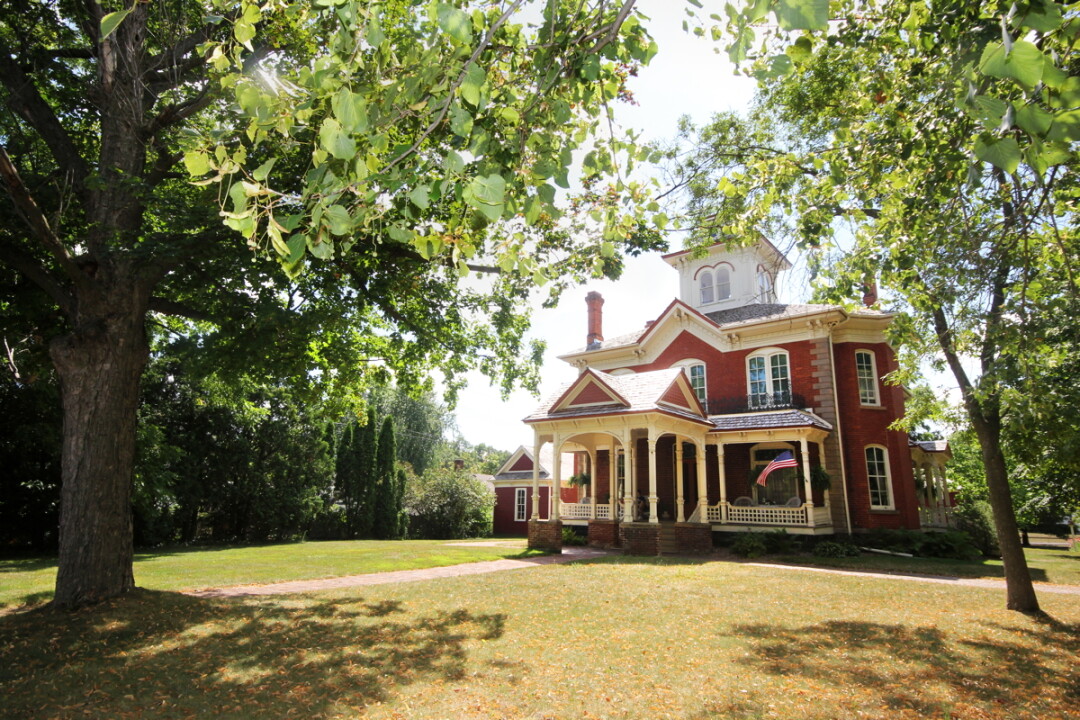Peek at the Past at the Cook-Rutledge Mansion
Historic Chippewa Falls home turns visitors into time travelers
Haley Wright, photos by Andrea Paulseth |

A tour of the Cook-Rutledge Mansion at 505 Grand Ave., Chippewa Falls – which is offered at 2pm Thursday through Sunday during the months of June, July, and August, as well as during the Christmas season – gives families the opportunity to walk into the past and learn how a few of the pillars of the community and their families lived more than a century ago.
HISTORY
The home was built on land purchased by attorney James Bingham and his wife, Justine, in 1873. Construction began immediately after the land was acquired, and according to curator Sandi Watson the home at that time was built from wood. (The brick exterior you see today was yet to come.) Bingham served in the state Assembly for two terms beginning in 1877, and in 1883 he was elected mayor of Chippewa Falls. After James Bingham passed away in 1885, Justine remained in the home until she sold it to Edward Rutledge in 1887. Watson reports that the Binghams were the only family to live in the residence with young children.
After purchasing the residence in 1887, lumberman Edward Rutledge and his wife, Hannah, began completely remodeling the home. Despite working in the lumber business his entire career, Rutledge rebuilt the entire “home in brick, with brick being a sign of affluence at the time,” Watson explained. Watson noted the Rutledges worked on the home the entire time they lived there and spared no expense in furnishing it with ornately decorated door handles, drawer handles, and light fixtures; hand-painted wall decorations; and a hand-carved staircase that took over two years to complete. Edward and Hannah Rutledge married somewhat later in life, and had no children together (although Hannah had a child from a previous marriage, Watson said). After Hannah passed away in 1910 and Edward in 1911, the home remained empty for a period of years while heirs were sought out. Watson said the search for heirs extended to Canada, where Rutledge (who was born in Ireland but had immigrated with his family to Canada) had “left home at the age of 15 years old to go into the woods and work.” An auction was held, and the entire contents of the home were sold, many to local collectors and families who still have the pieces and documentation of such. In the years since, some of the pieces have been donated back to the home.

After sitting empty for years, the mansion was sold in 1914 to the F. Weyerhaeuser Company, and then it was sold again in 1915 to Christopher Sundet, who subdivided part of the property into residential lots. This accounts for the fact that other residences now stand immediately adjacent to the mansion. Prior to this subdividing, Wilson said, “the property consisted of a full city block, with a pasture, chickens, horses, and cows.”
In 1915, the mansion changed hands again, to Dayton Cook, an attorney who also served as a local judge. Dayton Cook; his wife, Florence; and their two then-teenage children, Mabel and Maurice, moved into the home just before Christmas 1915, and at least one member of the Cook family continuously occupied the home until 1973, when Mabel Cook sold it to the Chippewa County Historical Society. Mabel Cook donated and sold many artifacts to the historical society, including correspondence, furniture, and other items. Furthermore, unique pieces – such as original spare wallpaper once purchased by the Rutledges – were found in the home, and these were used to restore it as close as possible to its original appearance.
OFFERINGS
The Cook-Rutledge Mansion was listed on the National Register of Historic Places in 1974. The Chippewa County Historical Society has worked very hard to restore the mansion, which is open to the public for a variety of purposes. Tours are offered four days a week throughout the summer months, and Christmas tours are available during the month of December. No appointment is necessary, and the tours, at least during the summer, start at 2pm sharp. The tour is $8 for adults and $1 for children ages 12 and under.
In addition to the regularly scheduled tours, the home is open to group tours – such as for school groups and other private groups – throughout the year. Additionally, the home may be rented for special events, such as weddings, luncheons, meetings, indoor and outdoor gatherings, and for photography purposes. Beginning in July, a film based on The Lumber Baron by local playwright Karen Hurd is being filmed at the home, Wilson said.

TREASURES
The home is full of unique pieces that belonged to the families that lived there and that have been donated to the Chippewa County Historical Society. Watson talked about how she can see history come alive for the children who come into the home. They see and can touch treasures of the past and learn about how those who came before them lived.
The rooms of the home are all fully furnished with period furniture, bedding, dishes, and décor, and there are period clothes and accessories in the bedrooms. Walking through the home, visitors could easily imagine a family still lives there (although a family that uses old-fashioned items that vistors may be seeing for the first time). Watson pointed out a few items that kids are drawn to, including a gorilla hair jacket that was donated by a family in Winona and a couple of life-sized Bru dolls which are featured in one of the bedrooms. The glass room on the roof is also a unique draw for visitors of all ages, and it provides a stunning view of Chippewa Falls.
For a unique and educational experience for the entire family, consider touring the Cook-Rutledge Mansion. To learn more, visit cookrutledgemansion.com.


















